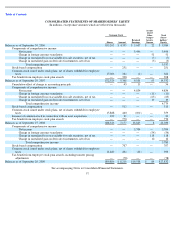Apple 2009 Annual Report Download - page 64
Download and view the complete annual report
Please find page 64 of the 2009 Apple annual report below. You can navigate through the pages in the report by either clicking on the pages listed below, or by using the keyword search tool below to find specific information within the annual report.
Table of Contents
an amendment of FASB Statement No. 115 ) ,
which allows companies to choose to measure eligible financial instruments and certain other
items at fair value that are not required to be measured at fair value. The Company has not elected the fair value option for any eligible financial
instruments.
Inventories
Inventories are stated at the lower of cost, computed using the first-in, first-
out method, or market. If the cost of the inventories exceeds their
market value, provisions are made currently for the difference between the cost and the market value. The Company’
s inventories consist
primarily of finished goods for all periods presented.
Property, Plant and Equipment
Property, plant and equipment are stated at cost. Depreciation is computed by use of the straight-
line method over the estimated useful lives of
the assets, which for buildings is the lesser of 30 years or the remaining life of the underlying building, up to five years for equipment, and the
shorter of lease terms or ten years for leasehold improvements. The Company capitalizes eligible costs to acquire or develop internal-
use
software that are incurred subsequent to the preliminary project stage. Capitalized costs related to internal-
use software are amortized using the
straight-
line method over the estimated useful lives of the assets, which range from three to five years. Depreciation and amortization expense on
property and equipment was $577 million, $363 million and $249 million during 2009, 2008 and 2007, respectively.
Asset Retirement Obligations
The Company records obligations associated with the retirement of tangible long-
lived assets and the associated asset retirement costs. The
Company reviews legal obligations associated with the retirement of long-
lived assets that result from the acquisition, construction, development
and/or normal use of the assets. If it is determined that a legal obligation exists, the fair value of the liability for an asset retirement obligation is
recognized in the period in which it is incurred if a reasonable estimate of fair value can be made. The fair value of the liability is added to the
carrying amount of the associated asset and this additional carrying amount is depreciated over the life of the asset. The difference between the
gross expected future cash flow and its present value is accreted over the life of the related lease as an operating expense. All of the Company’
s
existing asset retirement obligations are associated with commitments to return property subject to operating leases to original condition upon
lease termination. The Company’
s asset retirement liability was $25 million and $21 million as of September 26, 2009 and September 27, 2008,
respectively.
Long-Lived Assets Including Goodwill and Other Acquired Intangible Assets
The Company reviews property, plant and equipment and certain identifiable intangibles, excluding goodwill, for impairment. Long-
lived assets
are reviewed for impairment whenever events or changes in circumstances indicate the carrying amount of an asset may not be recoverable.
Recoverability of these assets is measured by comparison of their carrying amounts to future undiscounted cash flows the assets are expected to
generate. If property, plant and equipment and certain identifiable intangibles are considered to be impaired, the impairment to be recognized
equals the amount by which the carrying value of the assets exceeds its fair market value. The Company did not record any material impairments
during 2009, 2008 and 2007.
The Company does not amortize goodwill and intangible assets with indefinite useful lives, rather such assets are required to be tested for
impairment at least annually or sooner whenever events or changes in circumstances indicate that the assets may be impaired. The Company
performs its goodwill and intangible asset impairment tests on or about August 31 of each year. The Company did not recognize any goodwill or
intangible asset impairment charges in 2009, 2008 and 2007. The Company established reporting units based on its current reporting structure.
For purposes of testing goodwill for impairment, goodwill has been allocated to these reporting units to the extent it relates to each reporting
unit.
61
























